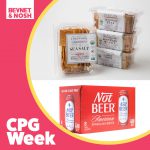Learnings from the 2015 Winter Fancy Food Show: Applying Trends and Building Innovation
It wasn’t just food and fun at the 40th annual Winter Fancy Food Show last week. There was also learning on top. We hit a couple of sessions off the floor to see what we could bring back for the FBU crowd. Two seminars in particular seemed important: “Making Food Trends Work for Your Business” and “Successful Innovations: It’s All in Your Mind.” Here’s what we saw:

Making Food Trends Work for Your Business
Trends have become such a huge phenomenon and force in the food and beverages industry. At the show, representatives ranging from small independent businesses to large brand management companies were busily scoping the aisles for the next big flavors, ingredients, foods, and beverages. Speakers Kara Nielsen, culinary director from the Sterling-Rice Group, and David Sax, journalist and author of The Tastemakers, shared their thoughts on what food trends really are, why they matter, and how to apply them to your own business.
“Food trends are manifestations of consumers’ needs,” Nielsen said.

“True trends meet the needs of many types of people,” Nielsen declared as she compared the Cronut with the now ubiquitous paleo-diet.
Sax noted that “food trends matter because trends build industry,” and pointed to Chipotle as an example for fast Mexican food and Bibibop, an Ohio-based Asian food chain, as an example for fast and healthy Asian cuisine. The presentation also pointed to sriracha’s popularity: the sale of hot sauce has grown 150 percent in the past 15 years, making way for numerous other brands of sriracha-based sauces and condiments.
But with trends identified, how do you make it work for your own individual business? The two speakers indicated that there are many drivers behind food trends – social, technological, economical, environmental, and political. When trends form from such factors, they are then passed through the consumers’ value system, which the Sterling-Rice Group calls “life drivers.” Life drivers include elements such as empowerment, achievement, joy, and integrity. This system of filtering eventually leads to the trends consumers choose to adopt.
Drawing a close parallel to “life drivers,” Nielsen and Sax explained that brands need to go through the same process as consumers and filter through which trends will work for their business and which trends won’t. Brands need to consider whether incoming trends match up with their values and plans for the company. Owners need to ask themselves whether they are adopting a trend just to jump on the bandwagon or if it is that the trend truly fits their brand.
Successful Innovations: It’s All in Your Mind.
“Real innovation isn’t just derivatives. It’s something completely new.”
That was how Beverly Emerson, President of Olive Tree, a consulting company for packaged foods and dietary supplements, described successful innovations. Her presentation gave advice on how to become a successful innovator and have a culture of creativity run through your organization.

Emerson suggested that entrepreneurs lean heavily on consumer feedback and social media tools (some of which she sells) as a way to inspire innovation. In the use of one of her clients, a “gripe water” (a colic remedy) called Mommy’s Bliss, she said social media feedback helped the company extend the brand by determining parent needs.
“The number one issue new moms have is a lack of sleep,” Emerson said.
In listening to their primary consumers, Mommy’s Bliss ended up building a successful line of products to help babies go to sleep, thus helping mom, and the line is now available in Walgreens and Walmart stores nationwide.
Emerson’s presentation also discussed the importance of having innovation permeate and grow throughout a company. In the latter half of the presentation, she emphasized the need for self-reflection from brands. She asked brand owners in the audience about whether they knew their customers and their customers’ motivations. She asked brand owners what differentiated them from the competition. And after talking about her first job at a cheese manufacturing company out of college, she asked brand owners whether they were fostering an atmosphere for innovative thinking to take place because her job at the cheese factory did not. “ You need to build a culture in the company where people can speak their opinion and be honored,” she said underscoring the importance of collaboration and healthy communication within the company.












